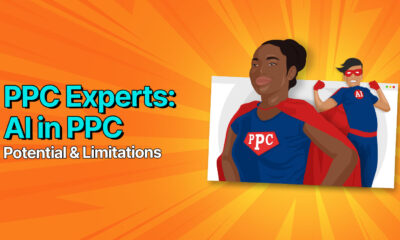MARKETING
5 Experts Reveal Their Secrets

Are you one of the 7.8 million Americans who commute to work every day? If so, I’m guessing you’ve listened to a podcast or two. You’re not alone. According to Infinite Dial, U.S. podcast audiences listen to an average of four to five podcasts per week.
The podcasting industry continues to grow YoY. In fact, Infinite Dial reports that, in 2021, 7 million more people were listening to podcasts than in 2020 alone.
That’s why it’s important to consider podcast advertising for your brand. Here, you’ll learn everything you need to know about podcast advertising — from top podcast advertising strategies to advertising rates and networks.
Podcast Expert Advertising Strategies
Before you get started with podcast advertising, consider this advice from the experts.
Use podcasting for brand awareness, not lead generation.
Rebekah Bek: As a UX writer for Ahrefs, Bek was put in charge of podcast sponsorships. She writes her advice for podcast advertising strategies in this Medium post. Here are the key takeaways:
- Rather than being a tool for lead generation, podcast advertising is a tool for gaining exposure and brand awareness.
- It’s not always about measurable ROI.
- Organic, not scripted, mentions perform best.
Understand your audience may have eclectic tastes.
Midroll: Midroll, a company that matches advertisers with shows , gives their advice to advertisers. Here is the key takeaway:
- It’s wise not to adhere too strictly to a category. Don’t assume that comedy audiences aren’t also entrepreneurs or that listeners to a sports podcast aren’t interested in a comedy special. You may be surprised at how broad and eclectic your audience tastes and needs are.
Ads read by the host perform better than third-party ads.
Jason Hoch: Former Chief Content Officer at HowStuffWorks, Hoch revealed what type of ads work best for their brand in an interview with DigiDay. Here are the key takeaways:
- Ads read by the host perform better than scripted, third-party ads placed in the podcast.
- Listeners feel like they are being shouted at with third-party ads.
- Consider producing organic mentions for better results.
Test and measure the success of your campaigns.
Kurt Kaufer: Partner and CMO at Ad Results Media, a podcast advertising agency, Kaufer wrote a survival guide for podcast advertising in this Forbes post. Here are the key takeaways:
- Measurement is the key to determining success in a podcast advertising campaign. Use promo codes, custom links, and post-checkout surveys to track success.
- Be comfortable knowing not every ad will work at first and that a breadth of shows will need to be tested to figure out what works and what doesn’t.
Measuring the success of your podcast campaigns is best done with a tool, like Casted, that gives you an overarching view of critical metrics. With the tool, you can access behavior metrics, demographic data, and traffic information that helps you understand your content’s true value.
You don’t need to sponsor the biggest podcasts, you can reach the same people on smaller shows.
Sam Balter: Former podcast marketer at HubSpot, Balter wrote about his podcast advertising learnings in this post. Plus, I spoke with him about his top podcast advertising strategies. Here are the key takeaways:
- Pre- and post-roll ad spots are generally cheaper than mid-roll and take less time. In addition, most ads have some sort of call-to-action that prompts listeners to go to a specific URL or use a discount code to get a discount.
- Podcast popularity and listenership will only continue to rise and so will the opportunity to connect with people in a new and novel way.
- When sponsoring podcasts, trust the host to deliver a message in their own voice.
- It’s better to go for frequency than reach. Pick a podcasts where you can purchase three to five ads versus one on a large podcast.
Podcast Advertising Rates 2022
The amount you pay for podcast advertising will vary depending on the length and type of the ad.
It’s essential to know that podcasts offer different pricing structures. Ads are sold on a cost per mille (CPM) or cost per acquisition (CPA) rate. CPM is the cost you’ll pay per 1,000 impressions or downloads. CPA is the cost you’ll pay to acquire a customer. Most ads are priced on a CPM model.
The current average cost of podcast advertising is a CPM of about $25.
AdvertiseCast notes that the average CPM for 30-second ads is $18, and the average CPM for 60-second ads is $25.

Podcast Advertising Networks
A podcast advertising network is an agency that connects companies or brands with respected podcasts on which to advertise. The goal is to take away the friction in podcast advertising by helping brands promote their products on podcasts and helping podcasters monetize their projects. A few examples include:
1. Midroll
Midroll, now part of SXM Media, is used by over 800 brands to buy ad spots on 300+ podcasts. With such a wide variety of shows, advertisers have the opportunity to use audience-based buying to ensure ads align with podcast topics most relevant to your brand, helping you accurately target relevant users and maximize reach.
Your ads can be pre-recorded or host read, the ladder being a valuable tool for generating brand trust as audiences trust hosts and see them as a valuable source of social proof.
Midroll prices ads on a CPM model, so you pay based on the number of certified downloads each episode receives. Its website notes that prices can range from $18 to $50 CPM, with higher performing shows being more expensive.
The advertiser portal also gives you an overview of campaign metrics, helping you see important data like forecasted downloads and ad placement cost per show.

2. Podcast One
Podcast One sees more than 2.1 billion annual downloads and 350 different episodes produced weekly, making it a high-impact platform for podcast advertisers.
It offers pre-recorded and live host endorsements, and you can use its geo-targeting and copy-split capabilities to ensure you target the right audiences and pick placements for your ads that are most relevant to your business.
With PodcastOne, you also have the unique ability to use visual integrations for your ads in the form of a sponsorship splash, an ad banner, or a forced video ad.
3. Megaphone
Megaphone offers powerful podcast advertising tools with the Spotify Audience Network, helping you target the most relevant listeners that are likely to drive the most impact across a wide variety of podcasts.
With the service, you can:
- Reach listeners according to their interests, purchase behavior, and things like apps, devices, and platforms that they use.
- Get actionable campaign insights that help you understand performance to ensure you have the right strategy.
- Use dynamic ad insertion to populate ads when downloaded so messaging is fresh and relevant.
Contact Megaphone to obtain pricing information.
4. AdvertiseCast
AdvertiseCast boasts 2,300+ podcasts, a 150,000,000+ monthly listener reach, and 4,200+ available ad spots to choose from, making it a valuable tool for podcast advertisers as you can select target audiences that are the best fit for your business.
You also have three different podcast ad opportunities to choose from:
- Baked-in host-read ads (its most popular option), where podcast hosts read your ads within the episode. Pricing is based on length (60 seconds or 30 seconds) and whether you select mid-roll or pre-roll placement.
- Dynamically inserted ads, which are pre-produced, pre-recorded and scheduled to be inserted into podcast content. Pricing is based on the average number of downloads in the first 30 days.
- Custom podcast ad units where you can be as creative as you’d like, like a social media plug for your profiles, a 10-second shout out, or a 90-second baked-in mid-roll ad.
AdvertiseCast also offers an end-to-end ad campaign platform that you can use to manage your ads and view detailed metrics that help you understand campaign performance. You can also make use of the full service solution, where AdvertiseCast manages the process for you.
Podcast Advertising Statistics 2022
1. There are around 2,000,000 podcast shows and over 48 million podcast episodes as of April 2021. (PodcastInsights, 2021)
2. 75% of the US population is familiar with the term “podcasting,” which is up 5% since 2019. (Infinite Dial, 2020)
3. Half of Podcast ads lasted longer in 30 seconds in length. (Interactive Advertising Bureau, 2021)
4. A survey of 300,000 listeners found that 63% of people bought something a host had prompted on their show. (AdvertiseCast)
5. Cost per mille (CPM) or cost per 1,000 listeners is the most common pricing method for podcasts. (AdvertiseCast, 2021)
6. Dynamically-inserted ads increased the share of revenues from 48% to 67%. (Interactive Advertising Bureau, 2021)
7. Streaming audio and podcasting is projected to be one of the channels with the largest growth in 2022, with a 17.8% increase. (Inside Radio, 2021)
8. Host-read and pre-product ads increased share of revenues from 27% to 35%. (Interactive Advertising Bureau, 2021)
9. Local advertising for streaming audio and podcasting will outperform targeted banner advertising and broadcast TV. (Inside Radio, 2021)
10. U.S. Podcast Ad Revenue is set to exceed 2 Billion by 2023. (Interactive Advertising Bureau, 2021)
Podcast advertising is a marketing tactic that is continuing to grow. As a majority of people have listened to a podcast, and engagement rates are increasing, brands can no longer ignore podcast advertising.
Source link
MARKETING
Tinuiti Marketing Analytics Recognized by Forrester

Rapid Media Mix Modeling and Proprietary Tech Transform Brand Performance
Tinuiti, the largest independent full-funnel performance marketing agency, has been included in a recent Forrester Research report titled, “The Marketing Analytics Landscape, Q2 2024.” This report comprehensively overviews marketing analytics markets, use cases, and capabilities. B2C marketing leaders can use this research by Principal Analyst Tina Moffett to understand the intersection of marketing analytics capabilities and use cases to determine the vendor or service provider best positioned for their analytics and insights needs. Moffett describes the top marketing analytics markets as advertising agencies, marketing dashboards and business intelligence tools, marketing measurement and optimization platforms and service providers, and media analytics tools.
As an advertising agency, we believe Tinuiti is uniquely positioned to manage advertising campaigns for brands including buying, targeting, and measurement. Our proprietary measurement technology, Bliss Point by Tinuiti, allows us to measure the optimal level of investment to maximize impact and efficiency. According to the Forrester report, “only 30% of B2C marketing decision-makers say their organization uses marketing or media mix modeling (MMM),” so having a partner that knows, embraces, and utilizes MMM is important. As Tina astutely explains, data-driven agencies have amplified their marketing analytics competencies with data science expertise; and proprietary tools; and tailored their marketing analytics techniques based on industry, business, and data challenges.
Our Rapid Media Mix Modeling sets a new standard in the market with its exceptional speed, precision, and transparency. Our patented tech includes Rapid Media Mix Modeling, Always-on Incrementality, Brand Equity, Creative Insights, and Forecasting – it will get you to your Marketing Bliss Point in each channel, across your entire media mix, and your overall brand performance.
As a marketing leader you may ask yourself:
- How much of our marketing budget should we allocate to driving store traffic versus e-commerce traffic?
- How should we allocate our budget by channel to generate the most traffic and revenue possible?
- How many customers did we acquire in a specific region with our media spend?
- What is the impact of seasonality on our media mix?
- How should we adjust our budget accordingly?
- What is the optimal marketing channel mix to maximize brand awareness?
These are just a few of the questions that Bliss Point by Tinuiti can help you answer.
Learn more about our customer-obsessed, product-enabled, and fully integrated approach and how we’ve helped fuel full-funnel outcomes for the world’s most digital-forward brands like Poppi & Toms.
The Landscape report is available online to Forrester customers or for purchase here.
MARKETING
Ecommerce evolution: Blurring the lines between B2B and B2C

Understanding convergence
B2B and B2C ecommerce are two distinct models of online selling. B2B ecommerce is between businesses, such as wholesalers, distributors, and manufacturers. B2C ecommerce refers to transactions between businesses like retailers and consumer brands, directly to individual shoppers.
However, in recent years, the boundaries between these two models have started to fade. This is known as the convergence between B2B and B2C ecommerce and how they are becoming more similar and integrated.
Source: White Paper: The evolution of the B2B Consumer Buyer (ClientPoint, Jan 2024)
What’s driving this change?
Ever increasing customer expectations
Customers today expect the same level of convenience, speed, and personalization in their B2B transactions as they do in their B2C interactions. B2B buyers are increasingly influenced by their B2C experiences. They want research, compare, and purchase products online, seamlessly transitioning between devices and channels. They also prefer to research and purchase online, using multiple devices and channels.
Forrester, 68% of buyers prefer to research on their own, online . Customers today expect the same level of convenience, speed, and personalization in their B2B transactions as they do in their B2C interactions. B2B buyers are increasingly influenced by their B2C experiences. They want research, compare, and purchase products online, seamlessly transitioning between devices and channels. They also prefer to research and purchase online, using multiple devices and channels
Technology and omnichannel strategies
Technology enables B2B and B2C ecommerce platforms to offer more features and functionalities, such as mobile optimization, chatbots, AI, and augmented reality. Omnichannel strategies allow B2B and B2C ecommerce businesses to provide a seamless and consistent customer experience across different touchpoints, such as websites, social media, email, and physical stores.
However, with every great leap forward comes its own set of challenges. The convergence of B2B and B2C markets means increased competition. Businesses now not only have to compete with their traditional rivals, but also with new entrants and disruptors from different sectors. For example, Amazon Business, a B2B ecommerce platform, has become a major threat to many B2B ecommerce businesses, as it offers a wide range of products, low prices, and fast delivery
“Amazon Business has proven that B2B ecommerce can leverage popular B2C-like functionality” argues Joe Albrecht, CEO / Managing Partner, Xngage. . With features like Subscribe-and-Save (auto-replenishment), one-click buying, and curated assortments by job role or work location, they make it easy for B2B buyers to go to their website and never leave. Plus, with exceptional customer service and promotional incentives like Amazon Business Prime Days, they have created a reinforcing loyalty loop.
And yet, according to Barron’s, Amazon Business is only expected to capture 1.5% of the $5.7 Trillion addressable business market by 2025. If other B2B companies can truly become digital-first organizations, they can compete and win in this fragmented space, too.”
If other B2B companies can truly become digital-first organizations, they can also compete and win in this fragmented space
Joe AlbrechtCEO/Managing Partner, XNGAGE
Increasing complexity
Another challenge is the increased complexity and cost of managing a converging ecommerce business. Businesses have to deal with different customer segments, requirements, and expectations, which may require different strategies, processes, and systems. For instance, B2B ecommerce businesses may have to handle more complex transactions, such as bulk orders, contract negotiations, and invoicing, while B2C ecommerce businesses may have to handle more customer service, returns, and loyalty programs. Moreover, B2B and B2C ecommerce businesses must invest in technology and infrastructure to support their convergence efforts, which may increase their operational and maintenance costs.
How to win
Here are a few ways companies can get ahead of the game:
Adopt B2C-like features in B2B platforms
User-friendly design, easy navigation, product reviews, personalization, recommendations, and ratings can help B2B ecommerce businesses to attract and retain more customers, as well as to increase their conversion and retention rates.
According to McKinsey, ecommerce businesses that offer B2C-like features like personalization can increase their revenues by 15% and reduce their costs by 20%. You can do this through personalization of your website with tools like Product Recommendations that help suggest related products to increase sales.
Focus on personalization and customer experience
B2B and B2C ecommerce businesses need to understand their customers’ needs, preferences, and behaviors, and tailor their offerings and interactions accordingly. Personalization and customer experience can help B2B and B2C ecommerce businesses to increase customer satisfaction, loyalty, and advocacy, as well as to improve their brand reputation and competitive advantage. According to a Salesforce report, 88% of customers say that the experience a company provides is as important as its products or services.
Market based on customer insights
Data and analytics can help B2B and B2C ecommerce businesses to gain insights into their customers, markets, competitors, and performance, and to optimize their strategies and operations accordingly. Data and analytics can also help B2B and B2C ecommerce businesses to identify new opportunities, trends, and innovations, and to anticipate and respond to customer needs and expectations. According to McKinsey, data-driven organizations are 23 times more likely to acquire customers, six times more likely to retain customers, and 19 times more likely to be profitable.
What’s next?
The convergence of B2B and B2C ecommerce is not a temporary phenomenon, but a long-term trend that will continue to shape the future of ecommerce. According to Statista, the global B2B ecommerce market is expected to reach $20.9 trillion by 2027, surpassing the B2C ecommerce market, which is expected to reach $10.5 trillion by 2027. Moreover, the report predicts that the convergence of B2B and B2C ecommerce will create new business models, such as B2B2C, B2A (business to anyone), and C2B (consumer to business).
Therefore, B2B and B2C ecommerce businesses need to prepare for the converging ecommerce landscape and take advantage of the opportunities and challenges it presents. Here are some recommendations for B2B and B2C ecommerce businesses to navigate the converging landscape:
- Conduct a thorough analysis of your customers, competitors, and market, and identify the gaps and opportunities for convergence.
- Develop a clear vision and strategy for convergence, and align your goals, objectives, and metrics with it.
- Invest in technology and infrastructure that can support your convergence efforts, such as cloud, mobile, AI, and omnichannel platforms.
- Implement B2C-like features in your B2B platforms, and vice versa, to enhance your customer experience and satisfaction.
- Personalize your offerings and interactions with your customers, and provide them with relevant and valuable content and solutions.
- Leverage data and analytics to optimize your performance and decision making, and to innovate and differentiate your business.
- Collaborate and partner with other B2B and B2C ecommerce businesses, as well as with other stakeholders, such as suppliers, distributors, and customers, to create value and synergy.
- Monitor and evaluate your convergence efforts, and adapt and improve them as needed.
By following these recommendations, B2B and B2C ecommerce businesses can bridge the gap between their models and create a more integrated and seamless ecommerce experience for their customers and themselves.
MARKETING
Streamlining Processes for Increased Efficiency and Results

How can businesses succeed nowadays when technology rules? With competition getting tougher and customers changing their preferences often, it’s a challenge. But using marketing automation can help make things easier and get better results. And in the future, it’s going to be even more important for all kinds of businesses.
So, let’s discuss how businesses can leverage marketing automation to stay ahead and thrive.
Benefits of automation marketing automation to boost your efforts
First, let’s explore the benefits of marketing automation to supercharge your efforts:
Marketing automation simplifies repetitive tasks, saving time and effort.
With automated workflows, processes become more efficient, leading to better productivity. For instance, automation not only streamlines tasks like email campaigns but also optimizes website speed, ensuring a seamless user experience. A faster website not only enhances customer satisfaction but also positively impacts search engine rankings, driving more organic traffic and ultimately boosting conversions.
Automation allows for precise targeting, reaching the right audience with personalized messages.
With automated workflows, processes become more efficient, leading to better productivity. A great example of automated workflow is Pipedrive & WhatsApp Integration in which an automated welcome message pops up on their WhatsApp
within seconds once a potential customer expresses interest in your business.
Increases ROI
By optimizing campaigns and reducing manual labor, automation can significantly improve return on investment.
Leveraging automation enables businesses to scale their marketing efforts effectively, driving growth and success. Additionally, incorporating lead scoring into automated marketing processes can streamline the identification of high-potential prospects, further optimizing resource allocation and maximizing conversion rates.
Harnessing the power of marketing automation can revolutionize your marketing strategy, leading to increased efficiency, higher returns, and sustainable growth in today’s competitive market. So, why wait? Start automating your marketing efforts today and propel your business to new heights, moreover if you have just learned ways on how to create an online business
How marketing automation can simplify operations and increase efficiency
Understanding the Change
Marketing automation has evolved significantly over time, from basic email marketing campaigns to sophisticated platforms that can manage entire marketing strategies. This progress has been fueled by advances in technology, particularly artificial intelligence (AI) and machine learning, making automation smarter and more adaptable.
One of the main reasons for this shift is the vast amount of data available to marketers today. From understanding customer demographics to analyzing behavior, the sheer volume of data is staggering. Marketing automation platforms use this data to create highly personalized and targeted campaigns, allowing businesses to connect with their audience on a deeper level.
The Emergence of AI-Powered Automation
In the future, AI-powered automation will play an even bigger role in marketing strategies. AI algorithms can analyze huge amounts of data in real-time, helping marketers identify trends, predict consumer behavior, and optimize campaigns as they go. This agility and responsiveness are crucial in today’s fast-moving digital world, where opportunities come and go in the blink of an eye. For example, we’re witnessing the rise of AI-based tools from AI website builders, to AI logo generators and even more, showing that we’re competing with time and efficiency.
Combining AI-powered automation with WordPress management services streamlines marketing efforts, enabling quick adaptation to changing trends and efficient management of online presence.
Moreover, AI can take care of routine tasks like content creation, scheduling, and testing, giving marketers more time to focus on strategic activities. By automating these repetitive tasks, businesses can work more efficiently, leading to better outcomes. AI can create social media ads tailored to specific demographics and preferences, ensuring that the content resonates with the target audience. With the help of an AI ad maker tool, businesses can efficiently produce high-quality advertisements that drive engagement and conversions across various social media platforms.
Personalization on a Large Scale
Personalization has always been important in marketing, and automation is making it possible on a larger scale. By using AI and machine learning, marketers can create tailored experiences for each customer based on their preferences, behaviors, and past interactions with the brand.
This level of personalization not only boosts customer satisfaction but also increases engagement and loyalty. When consumers feel understood and valued, they are more likely to become loyal customers and brand advocates. As automation technology continues to evolve, we can expect personalization to become even more advanced, enabling businesses to forge deeper connections with their audience. As your company has tiny homes for sale California, personalized experiences will ensure each customer finds their perfect fit, fostering lasting connections.
Integration Across Channels
Another trend shaping the future of marketing automation is the integration of multiple channels into a cohesive strategy. Today’s consumers interact with brands across various touchpoints, from social media and email to websites and mobile apps. Marketing automation platforms that can seamlessly integrate these channels and deliver consistent messaging will have a competitive edge. When creating a comparison website it’s important to ensure that the platform effectively aggregates data from diverse sources and presents it in a user-friendly manner, empowering consumers to make informed decisions.
Omni-channel integration not only betters the customer experience but also provides marketers with a comprehensive view of the customer journey. By tracking interactions across channels, businesses can gain valuable insights into how consumers engage with their brand, allowing them to refine their marketing strategies for maximum impact. Lastly, integrating SEO services into omni-channel strategies boosts visibility and helps businesses better understand and engage with their customers across different platforms.
The Human Element
While automation offers many benefits, it’s crucial not to overlook the human aspect of marketing. Despite advances in AI and machine learning, there are still elements of marketing that require human creativity, empathy, and strategic thinking.
Successful marketing automation strikes a balance between technology and human expertise. By using automation to handle routine tasks and data analysis, marketers can focus on what they do best – storytelling, building relationships, and driving innovation.
Conclusion
The future of marketing automation looks promising, offering improved efficiency and results for businesses of all sizes.
As AI continues to advance and consumer expectations change, automation will play an increasingly vital role in keeping businesses competitive.
By embracing automation technologies, marketers can simplify processes, deliver more personalized experiences, and ultimately, achieve their business goals more effectively than ever before.
-

 SEARCHENGINES7 days ago
SEARCHENGINES7 days agoGoogle Core Update Volatility, Helpful Content Update Gone, Dangerous Google Search Results & Google Ads Confusion
-

 SEO7 days ago
SEO7 days ago10 Paid Search & PPC Planning Best Practices
-

 MARKETING5 days ago
MARKETING5 days ago5 Psychological Tactics to Write Better Emails
-

 SEARCHENGINES6 days ago
SEARCHENGINES6 days agoWeekend Google Core Ranking Volatility
-

 MARKETING6 days ago
MARKETING6 days agoThe power of program management in martech
-

 SEO6 days ago
SEO6 days agoWordPress Releases A Performance Plugin For “Near-Instant Load Times”
-

 PPC5 days ago
PPC5 days ago20 Neuromarketing Techniques & Triggers for Better-Converting Copy
-
SEARCHENGINES4 days ago
Daily Search Forum Recap: April 15, 2024

















You must be logged in to post a comment Login